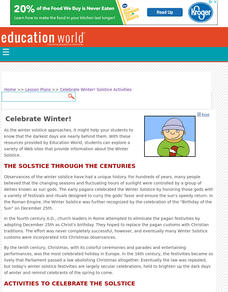Stanford University
Solstice and Equinox Season Model
How can December 21 be the shortest day of the year when all days are 24 hours long? Pupils see how to build a model showing the differences between winter and summer solstices and equinoxes. Using this model, classes can then discuss...
Curated OER
Winter and Summer Storms Scenarios
Fourth graders discover the patterns that create summer and winter storms. Working in groups, they create model storms for summer and winter. Students discuss the reasons why summer storms and winter storms are different and explain...
Core Knowledge Foundation
A Time for All Seasons - Summer
The sun is shining and the birds are singing, what better time to teach young learners about the fun season of summer. In this week-long science series, children learn how the rotation and orbit of the earth influence the days and...
Texas Instruments
Sands of Time
Twelfth graders explore an application of integration. A calculus lesson prompts class members to find the length of the day where they live during the winter and summer solstice. Using data relating to the solstices at various...
Curated OER
Student Exploration: Summer and Winter
In this recognizing the seasons online/interactive instructional activity, students explore the Earth's positions and determine the summer and winter season. Students answer 21 short answer questions
Curated OER
The Solstices
Compare surface temperatures when the solstice occurs in the different hemispheres. Young scientists draw conclusions from their investigation of data collected using spreadsheets and a globe.
Curated OER
Determining Hours of Daylight
In this daylight hours worksheet, students will study illustrations showing the length of day at every 10-degrees of latitude for the winter and summer solstices. Students will complete 4 short answer questions based on the illustrations.
Curated OER
Bill Nye Video: Earth's Seasons
In this earth's seasons activity, students answer fill in the blank questions after seeing Bill Nye's video. Topics include the rotation of the earth around the sun, the tilt of the earth, the time zones and sunlight.
Curated OER
Winter Holidays
Students investigate the traditions associated with winter holidays. They examine why most of the holidays are associated with light. They examine the origins and customs of these holidays before creating an original holiday.
Curated OER
The Winter Solstice
In this winter solstice learning exercise, students read a detailed text about the winter solstice and the historical and religious significance of this day. Students then complete a 15 question fill-in-the-blank and true/false learning...
Curated OER
Solstice and Equinox
Students identify the dates of the solstices and equinoxes and how they relate to the various seasons on Earth. After discussing how the solstice and equinox affect the seasons, students use their bodies to demonstrate the how each...
Curated OER
Motions and Their Effects
With a simple blackboard-style appearance, these slides list facts about the reason for the seasons, solstices, and equinoxes. It also touches on Kepler's first law of planetary motion. There are no pictures or graphics to help explain...
Curated OER
Celebrate Winter!
Students understand, and participate in, both the historical and scientific aspects of this year's celebrations by introducing them to a selection of activities.
S2tem Centers SC
Seasons
Winter, spring, summer, and fall—take the learning of the seasons beyond the elementary level to the middle school classroom. Curious learners begin by watching videos about the seasons and the rotation of planet Earth. Then, they...
Weber State University
The Sun and the Seasons
Why is there more daylight in June than in December if you live above the equator? How does the angle of sunlight shift throughout the year? Answer these questions and more with an interactive article about the sun, its path through the...
Curated OER
Seeing Solar Processes
In this seasons learning exercise, students compare 24 hour filmstrips for a single day in Canada, the U.S.A., and the Arctic Circle to determine the different seasons. This learning exercise has 12 fill in the blank.
Curated OER
The Sun's Path
Starting with questions about the tilt of the Earth and apparent motion of the sun, a learning exercise provides instructions on how to figure the paths of the Sun on certain dates. Learners answer three more questions, complete with...
Curated OER
Apparent Motion of the Sun
Demonstrate the path of the sun across the sky at different times of the year with an engaging science lesson. Learners use a series of questions and diagrams to examine the movement of the sun and appearance of the sky around their...
Curated OER
Exploring Seasonal Shadows and Sunlight
What can shadows tell us about the changing season? Over several months, astronomy learners record length and position of an outdoor object's shadow, such as a flagpole. They apply the data to a growing hypothesis and note the patterns...
Curated OER
The Seasons
Discover the change of the seasons by modeling the Earth-Sun system. Learners model the orbit of the Earth around the sun and explore how and why the patterns of winter and summer occur.
Curated OER
Solstice And Equiniox Curriculum
Students engage in a lesson that investigates finding the dates of the solstices and equinoxes. They define the terms related to the concept and conduct research in order to explain the physical occurrences. They also relate to how the...
Curated OER
Seasons' Journey: As the World Turns
Fourth graders explore the earth's revolution around the sun and the changes in weather that follow this motion.
CK-12 Foundation
Seasons: Shadow Lengths
Before iPhones and calendars, how did humans determine the seasons of the year? Middle school scientists discover how to use shadows to determine the time of year in an enlightening interactive. Pupils manipulate the sun and examine the...
Curated OER
A New Slant On The Seasons
Students identify how the tilt and position of the Earth causes the seasons. After a discussion of the seasons and when they begin. Using themselves as the objects in the universe, they role play how the rotational movement of the...

























